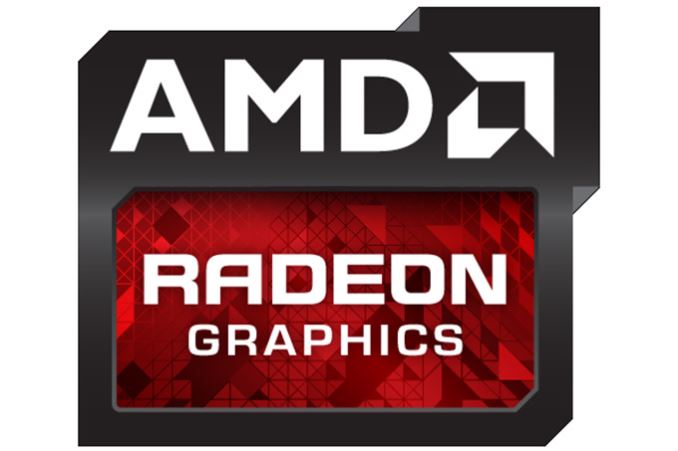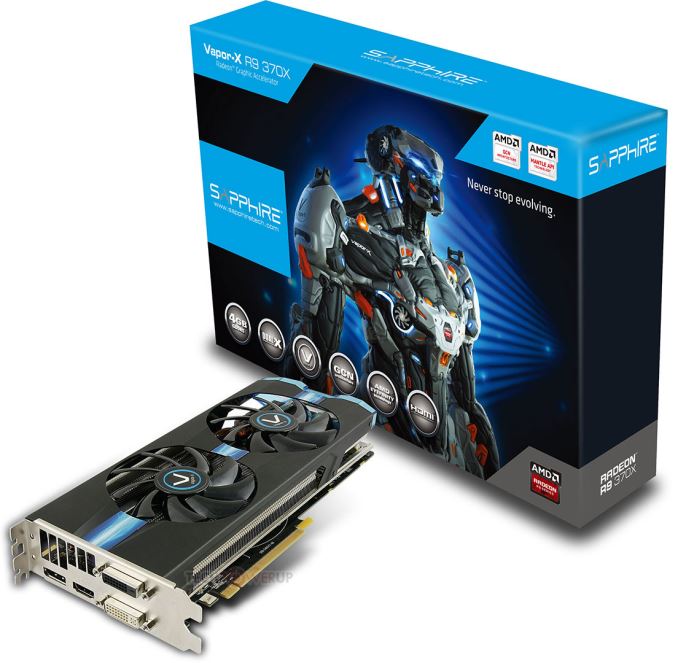AMD Quietly Releases Radeon R9 370X, China-Only For Now
by Ryan Smith on August 28, 2015 3:30 PM EST- Posted in
- GPUs
- AMD
- Radeon
- Radeon 300

Back in June when AMD launched the Radeon 300 series, AMD made the unusual move of only releasing refresh SKUs for around half of their products. While the 390 series saw the release of the vanilla 390 and 390X parts, the 380, 370, and 360 were all released with just one SKU respectively. Furthermore all three parts were the second-tier configurations for their respective GPUs, each packing a partially disabled GPU. At the time we suspected that AMD was simply holding back some SKUs to avoid flooding the market all at once and to release those SKUs at a more convenient opportunity, and it looks like this is indeed the case.
Alongside yesterday’s R9 Nano unveil, AMD also quietly launched the R9 370X. The unexpectedly quiet launch of the SKU is due to the fact that AMD is only releasing it on a regional basis, at least for the time being. As reported by PCWorld, who received confirmation from AMD, the R9 370X is only going to be available in China at this time.
The China-only launch of the R9 370X comes shortly after the launch of NVIDIA’s GeForce GTX 950, a card that we expect will be especially popular in China given pricing, economics, and the specific popularity of free-to-play games in that market. As a result, AMD releasing a China-only SKU, while not normal, is not without merit since it’s likely going to be China and the greater APAC region where the real fight over sales volume for this class of parts will be. Still, we also expect that R9 370X will eventually come to North America, similar to how AMD rolled out some of the 200 series SKUs.
| AMD GPU Specification Comparison | ||||||
| AMD Radeon R9 370X | AMD Radeon R7 370 | AMD Radeon R9 270X | AMD Radeon HD 7870 | |||
| Stream Processors | 1280 | 1024 | 1280 | 1280 | ||
| Texture Units | 80 | 64 | 80 | 80 | ||
| ROPs | 32 | 32 | 32 | 32 | ||
| Core Clock | ? | 925MHz | 1000MHz | 1000MHz | ||
| Boost Clock | ? | 975MHz | 1050MHz | N/A | ||
| Memory Clock | 5.6Gbps GDDR5 | 5.6Gbps GDDR5 | 5.6Gbps GDDR5 | 4.8Gbps GDDR5 | ||
| Memory Bus Width | 256-bit | 256-bit | 256-bit | 256-bit | ||
| VRAM | 2GB/4GB | 2GB | 2GB | 2GB | ||
| FP64 | 1/16 | 1/16 | 1/16 | 1/16 | ||
| TrueAudio | N | N | N | N | ||
| Transistor Count | 2.8B | 2.8B | 2.8B | 2.8B | ||
| Typical Board Power | ? | 110W | 180W | 190W | ||
| Manufacturing Process | TSMC 28nm | TSMC 28nm | TSMC 28nm | TSMC 28nm | ||
| Architecture | GCN 1.0 | GCN 1.0 | GCN 1.0 | GCN 1.0 | ||
| GPU | Pitcairn | Pitcairn | Pitcairn | Pitcairn | ||
| Launch Date | China-Only | 06/18/15 | 10/08/13 | 03/05/12 | ||
| Launch Price | N/A | $149 | $199 | $349 | ||
As for the R9 370X itself, the SKU is the refresh successor to the R9 270X. This means we’re looking at a fully-enabled Pitcairn GPU with all 1280 stream processors enabled. This marks the fourth such desktop SKU for the full Pitcairn configuration, following the original Radeon HD 7870 and the R9 270 & 270X, both of the latter being fully enabled parts.
| AMD Radeon Product Evolution | |||||
| Predecessor | GPU | Successor | |||
| Radeon R9 290X | Hawaii | Radeon R9 390X | |||
| Radeon R9 285 | Tonga | Radeon R9 380 | |||
| Radeon R9 270/270X Radeon HD 7870 |
Pitcairn | Radeon R9 370X | |||
| Radeon R7 265 Radeon HD 7850 |
Radeon R7 370 | ||||
| Radeon R9 260 | Bonaire | Radeon R9 360 | |||
At this time we don’t have official AMD specifications for the R9 370X SKU (nor do we expect to get them). Furthermore based on information released by TechPowerUp, the first card released is a factory overclocked Sapphire model, so we have limited information available on clockspeeds. However based on the 5.6Gbps memory speed, it would appear that this is closer to a straight re-badge than was the case with the release of the 200 series, as AMD reworked their board designs to improve memory clockspeeds for that refresh.

Sapphire's R9 370X Vapor X (Image Courtesy TechPowerUp)
In any case, while the R9 370X is China-only for the time being, don't be too surprised if we see it released in North America before too long, especially once R9 270 series supplies start dropping.
Sources: TechPowerUp & PCWorld










26 Comments
View All Comments
Jtaylor1986 - Friday, August 28, 2015 - link
Are they just using these for price segmentation reasons? I can't imagine this chip still needs to be cut down from binning 4 years into production.Egg - Friday, August 28, 2015 - link
They're fully enabled, I think?Egg - Friday, August 28, 2015 - link
Oops, never mind, 370 is cut.P39Airacobra - Friday, September 25, 2015 - link
I think you are confusing this one with the 370 non X, The 370X is the fully unlocked Pitcairn/Curacao/Trinidad or whatever it is called now.eanazag - Friday, August 28, 2015 - link
Aside from AMD's financial restrictions. AMD's poor sales is in line with their addiction to straight rebadges. Here is some advice AMD: add value with your rebadge. Add a software feature that wasn't included in the previous generation to add value to the same meal you try to feed us for 4 years straight. The other thing is to spend a little more effort with your rebadging. A better lineup would be R9 380=a further cut down 290 where the end result lowers power requirements too; R 370X= 285 and the 370= cut down 285. R7 360 has a single slot 260.GCN 1.0 should be out of the market. We should see GCN 1.2 and 1.1. You will save money in driver support in the longer term especially with the advances Windows 10 and DX 12 bring. Plus that means more DSP audio support that came with Hawaii and Bonaire for developers.
I'm gonna say it.....AMD is not well run. They have resources to stay semi competitive in the market and fail to take advantage of them by playing their cards smart. The 370 is $150-$180 on Newegg. The 370X will likely bump to $200. That's a lot of money for something you could have bought for nearly the same price several years ago.
AS118 - Friday, August 28, 2015 - link
I totally agree. Acting the way they are given how badly Nvidia has been beating them (pretty much throughout their entire history) is arrogant, and I don't see how they expect to gain marketshare or mindshare this way.For crying out loud, the 370 is actually less powerful than the 270 series! I'm an AMD fan myself, but my mind boggles at their marketing "tactics" and customer service decisions sometimes.
Alexvrb - Monday, August 31, 2015 - link
They would often swap positions, actually. If it wasn't for ATI/AMD's competitiveness over the years, Nvidia would still be hawking a Geforce MX line to unfortunates who can't afford their top tier product.HighTech4US - Monday, August 31, 2015 - link
No they DO NOT swap positions often. The last time they did was in the 2004/2005 period.Since 2005 it has been Nvidia gradually pulling ahead so that by 2007 it was Nvidia 60% vs ATI/AMD's 40%.
That 60/40 split continued until 1 year ago (2014 Q2) when AMD started to implode quarter after quarter to be where the split is now 82% for Nvidia and 18% for AMD.
Nvidia sells 9 GPUs for every 2 GPUs that AMD sells.
https://forum.beyond3d.com/posts/1867800
Alexvrb - Monday, August 31, 2015 - link
I was primarily thinking in terms of performance, myself. I don't personally buy a card based on how many other people buy it. Heck I bought a Kyro and a Kyro II back when they provided excellent performance/dollar, and they were fantastic for their day.medi03 - Saturday, August 29, 2015 - link
BS.When competitor has pathetic product, that loses an all fronts, performance, price, heat. He loses mere couple of % of the market. (oh, and Anandtech comparing cherry picked Fermi chip to stock AMD has nothing to do with it, cough).
Now AMD has chips that are competitive, generate a bit more heat (10-30%-ish difference on entire system) but are also cheaper. And yeehaa, it's market share shrinks in half.
Thank god AMD managed to evade G-Sync shitstrike.